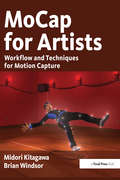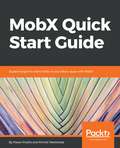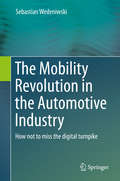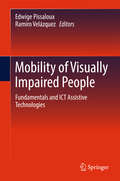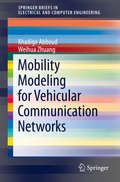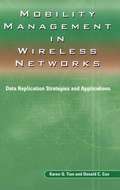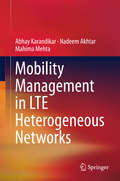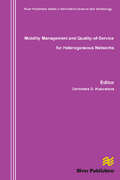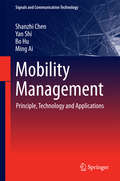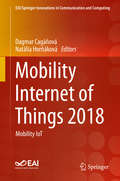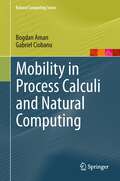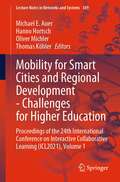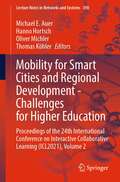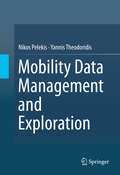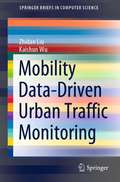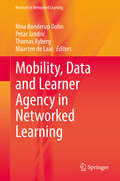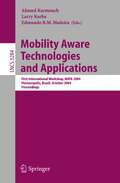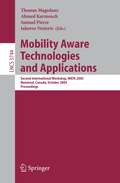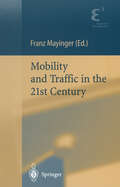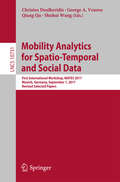- Table View
- List View
MoCap for Artists: Workflow and Techniques for Motion Capture
by Midori Kitagawa Brian WindsorMake motion capture part of your graphics and effects arsenal. This introduction to motion capture principles and techniques delivers a working understanding of today's state-of-the-art systems and workflows without the arcane pseudocodes and equations. Learn about the alternative systems, how they have evolved, and how they are typically used, as well as tried-and-true workflows that you can put to work for optimal effect. Demo files and tutorials provided on the downloadable resources deliver first-hand experience with some of the core processes.
MoCap for Artists: Workflow and Techniques for Motion Capture
by Midori Kitagawa Brian WindsorMake motion capture part of your graphics and effects arsenal. This introduction to motion capture principles and techniques delivers a working understanding of today's state-of-the-art systems and workflows without the arcane pseudocodes and equations. Learn about the alternative systems, how they have evolved, and how they are typically used, as well as tried-and-true workflows that you can put to work for optimal effect. Demo files and tutorials provided on the downloadable resources deliver first-hand experience with some of the core processes.
MobX Quick Start Guide: Supercharge the client state in your React apps with MobX
by Pavan Podila Michel WeststrateApply functional Reactive programming for simple and scalable state management with MobX Key Features The easiest way to learn MobX to enhance your client-side state-management Understand how the concepts and components fit together Work through different state management scenarios with MobX Book Description MobX is a simple and highly scalable state management library in JavaScript. Its abstractions can help you manage state in small to extremely large applications. However, if you are just starting out, it is essential to have a guide that can help you take the first steps. This book aims to be that guide that will equip you with the skills needed to use MobX and effectively handle the state management aspects of your application. You will first learn about observables, actions, and reactions: the core concepts of MobX. To see how MobX really shines and simplifies state management, you'll work through some real-world use cases. Building on these core concepts and use cases, you will learn about advanced MobX, its APIs, and libraries that extend MobX. By the end of this book, you will not only have a solid conceptual understanding of MobX, but also practical experience. You will gain the confidence to tackle many of the common state management problems in your own projects. What you will learn Explore the fundamental concepts of MobX, such as observables, actions, and reactions Use observables to track state and react to its changes with validations and visual feedback (via React Components) Create a MobX observable from different data types Define form data as an observable state and tackle sync and async form validations Use the special APIs to directly manipulate observables, tracking its changes, and discovering the reasons behind a change Tackle any state management issue you may have in your app by combining mobx-utils and mobx-state-tree Explore the internals of the MobX reactive system by diving into its inner workings Who this book is for This book is for web developers who want to implement easy and scalable state management for their apps. Knowledge of HTML, CSS, and JavaScript is assumed
MobX Quick Start Guide: Supercharge the client state in your React apps with MobX
by Pavan Podila Michel WeststrateApply functional Reactive programming for simple and scalable state management with MobX Key Features The easiest way to learn MobX to enhance your client-side state-management Understand how the concepts and components fit together Work through different state management scenarios with MobX Book Description MobX is a simple and highly scalable state management library in JavaScript. Its abstractions can help you manage state in small to extremely large applications. However, if you are just starting out, it is essential to have a guide that can help you take the first steps. This book aims to be that guide that will equip you with the skills needed to use MobX and effectively handle the state management aspects of your application. You will first learn about observables, actions, and reactions: the core concepts of MobX. To see how MobX really shines and simplifies state management, you'll work through some real-world use cases. Building on these core concepts and use cases, you will learn about advanced MobX, its APIs, and libraries that extend MobX. By the end of this book, you will not only have a solid conceptual understanding of MobX, but also practical experience. You will gain the confidence to tackle many of the common state management problems in your own projects. What you will learn Explore the fundamental concepts of MobX, such as observables, actions, and reactions Use observables to track state and react to its changes with validations and visual feedback (via React Components) Create a MobX observable from different data types Define form data as an observable state and tackle sync and async form validations Use the special APIs to directly manipulate observables, tracking its changes, and discovering the reasons behind a change Tackle any state management issue you may have in your app by combining mobx-utils and mobx-state-tree Explore the internals of the MobX reactive system by diving into its inner workings Who this book is for This book is for web developers who want to implement easy and scalable state management for their apps. Knowledge of HTML, CSS, and JavaScript is assumed
MobX Quick Start Guide: Supercharge The Client State In Your React Apps With Mobx
by Michel WeststrateMobX is one of the most simple and scalable state management JavaScript libraries. It helps you to write code faster and maintain bigger applications, but can be difficult to take your first steps with. With this book you will become confident using MobX to handle the state management of your application.
The Mobility Revolution in the Automotive Industry: How not to miss the digital turnpike
by Dr. Sebastian WedeniwskiThe Internet of Things, cloud computing, connected vehicles, Big Data, analytics — what does this have to do with the automotive industry? This book provides information about the future of mobility trends resulting from digitisation, connectedness, personalisation and data insights. The automotive industry is on the verge of undergoing a fundamental transformation. Large, traditional companies in particular will have to adapt, develop new business models and implement flexibility with the aid of appropriate enterprise architectures. Transforming critical business competencies is the key concept. The vehicle of the digital future is already here — who will shape it?
Mobility of Visually Impaired People: Fundamentals and ICT Assistive Technologies
by Edwige Pissaloux Ramiro VelazquezThis book discusses the design of the new mobility assistive information and communication technologies (ICT) devices for the visually impaired. The book begins with a definition of the space concept, followed by the concept of interaction with a space during mobility and this interaction characteristics. The contributors will then examine the neuro-cognitive basis of space perception for mobility and different theories of space perception. The text presents the existing technologies for space perception (sense recovery with stem and iPS cells, implants, brain plasticity, sensory substitution devices, multi modal technologies, etc.), the newest technologies for mobility assistance design, the way the feedback on environment is conveyed to the end-user. Methods for formative and summative evaluations of the mobility devices will also be discussed. The book concludes with a look to the future trends in research and technology development for mobility assistive information and communication technologies.
Mobility Modeling for Vehicular Communication Networks (SpringerBriefs in Electrical and Computer Engineering)
by Khadige Abboud Weihua ZhuangThis brief presents a stochastic microscopic mobility model that describes the temporal changes of intervehicle distances. The model is consistent with simulated and empirical vehicle traffic patterns. Using stochastic lumpability methods, the proposed mobility model is mapped into an aggregated mobility model that describes the mobility of a group of vehicles. In addition, the proposed mobility model is used to analyze the spatiotemporal VANET topology. Two metrics are proposed to characterize the impact of vehicle mobility on VANET topology: the time period between successive changes in communication link state (connection and disconnection) and the time period between successive changes in node’s one-hop neighborhood. Using the proposed lumped group mobility model, the two VANET topology metrics are probabilistically characterized for different vehicular traffic flow conditions. Furthermore, the limiting behavior of a system of two-hop vehicles and the overlap-state of their coverage ranges is modeled, and the steady-state number of common vehicle neighbors between the two vehicles is approximately derived. The proposed mobility model will facilitate mathematical analysis in VANETs. The spatiotemporal VANET topology analysis provides a useful tool for the development of mobility-aware vehicular network protocols. Mobility Modeling for Vehicular Communication Networks is designed for researchers, developers, and professionals involved with vehicular communications. It is also suitable for advanced-level students interested in communications, transport infrastructure, and infotainment applications.
Mobility Management in Wireless Networks: Data Replication Strategies and Applications (Ercoftac Ser.)
by Karen Q. Tian Donald C. CoxIn wireless communication systems, the network keeps track of a user’s location through an up-to-date user profile stored in various databases. A user profile contains not only a user’s current location information, but also service information, such as billing and authentication. The cov- age area of an access network is divided into registration areas (RAs), and each RA is associated with a location database. The two basic op- ations in mobility management are location update and location lookup. When a user moves across the boundaries of these RAs, the network updates his location information in the pertinent databases. When a caller places a call using the callee’s identification, the network queries the relevant database(s) to obtain the current location and other service information of the callee. The performance of mobility management can be further enhanced by using replicas of user profiles which may be kept at various locations. Replication techniques make profile information more readily available, thus reducing lookup cost and latency, but to keep these replicas c- sistent and fresh, they must be updated whenever the user profile is updated. The principle of replication is to replicate if the benefit of replication is greater than its overhead. The difficulty, however, lies in accurately measuring the benefit and overhead.
Mobility Management in LTE Heterogeneous Networks
by Abhay Karandikar Nadeem Akhtar Mahima MehtaThis book is the first of its kind, compiling information on the Long-Term Evolution (LTE) standards, which are enhanced to address new mobility-related challenges in Heterogeneous Networks (HetNets). It identifies the related challenges and discusses solutions and the simulation methodology for modeling HetNet mobility – cutting-edge information that was previously accessible only in the form of 3GPP specifications and documents, and research papers. The book reviews the current LTE mobility framework and discusses some of the changes for enhancing mobility management in HetNets. It describes the measurement procedures, handover (HO) mechanisms and HO success/failure scenarios. HetNets are intended to provide very high spectral efficiency while ensuring seamless coverage by deploying low-power nodes within the umbrella macrocell network. While mobility management in homogeneous networks is well understood, LTE standards are being enhanced to address the HetNet-specific mobility management challenges emerging. The book addresses these aspects in a succinct and understandable form, offering a valuable resource for researchers and professionals working in the area of HetNet mobility and a ready reference guide for practicing engineers and researchers.
Mobility Management and Quality-Of-Service for Heterogeneous Networks
by Demetres D. KouvatsosConsiderable attention is currently devoted worldwide towards mobility issues and challenges such as those arising from the integration of the next generation Internet over terrestrial digital TV, mobile user location management and multi-service mobile networks subject to quality of service (QoS) routing.This book follows Heterogeneous Networks: Performance Modelling and Analysis, describes recent advances in mobile and wireless networks and the Internet reflecting the state-of-the-art technology and research achievements in mobility management, performance enhancement, optimal admission control and QoS worldwide.Technical topics discussed in the book include• Mobility Management;• Optimal Admission Control;• Performance Modelling Studies;• Access Network Coverage;• Quality of Service (QoS);Heterogeneous Networks: Mobility Management and Quality of Service contains recently extended research papers, which have their roots in the series of the HET-NETs International Working Conferences focusing on the 'Performance Modelling and Evaluation of Heterogeneous Networks' under the auspices of the EU Networks of Excellence Euro-NGI and Euro-FGI.Heterogeneous Networks: Mobility Management and Quality of Service, is ideal for personnel in computer/communication industries as well as academic staff and master/research students in computer science, operational research, electrical engineering and telecommunication systems.ContentsPreface; Participants of the Reviewing Process;• Traffic Modelling and Characterisation;• Queueing and Interconnection Networks;• Performance Evaluation Studies;• TCP Performance Analysis;• Congestion Control;• Application Layer Multicast;• Numerical and Software Tools; Author Index; Keyword Index.
Mobility Management and Quality-Of-Service for Heterogeneous Networks
Considerable attention is currently devoted worldwide towards mobility issues and challenges such as those arising from the integration of the next generation Internet over terrestrial digital TV, mobile user location management and multi-service mobile networks subject to quality of service (QoS) routing.This book follows Heterogeneous Networks: Performance Modelling and Analysis, describes recent advances in mobile and wireless networks and the Internet reflecting the state-of-the-art technology and research achievements in mobility management, performance enhancement, optimal admission control and QoS worldwide.Technical topics discussed in the book include• Mobility Management;• Optimal Admission Control;• Performance Modelling Studies;• Access Network Coverage;• Quality of Service (QoS);Heterogeneous Networks: Mobility Management and Quality of Service contains recently extended research papers, which have their roots in the series of the HET-NETs International Working Conferences focusing on the 'Performance Modelling and Evaluation of Heterogeneous Networks' under the auspices of the EU Networks of Excellence Euro-NGI and Euro-FGI.Heterogeneous Networks: Mobility Management and Quality of Service, is ideal for personnel in computer/communication industries as well as academic staff and master/research students in computer science, operational research, electrical engineering and telecommunication systems.ContentsPreface; Participants of the Reviewing Process;• Traffic Modelling and Characterisation;• Queueing and Interconnection Networks;• Performance Evaluation Studies;• TCP Performance Analysis;• Congestion Control;• Application Layer Multicast;• Numerical and Software Tools; Author Index; Keyword Index.
Mobility Management: Principle, Technology and Applications (Signals and Communication Technology)
by Shanzhi Chen Yan Shi Bo Hu Ming AiThis is the first book devoted to mobility management, covering the important principles, technologies and applications of mobility management based on years of academic research and industry experiences. The content is organized according to the reference models proposed by the authors, and emphasizes on technical principles rather than protocol details; a systematic and comprehensive introduction is presented yet without losing focuses; the existing technologies in cellular system, mobile Internet and IMS/SIP are also extensively compared. This book can be an indispensable reference for mobile communication engineers, computer network engineers, researchers and anyone else involved in academic, industrial and standardization activities on mobility management.
Mobility Internet of Things 2018: Mobility IoT (EAI/Springer Innovations in Communication and Computing)
by Dagmar Cagáňová Natália HorňákováThe scientific monograph Mobility IoT deals with innovative technologies influencing industry and connectivity sectors in the future industrial, urban, social and sustainable development. The mobility and Internet of Things are worldwide phenomena almost in everyday life. It is a challenge in many industries, not only in car manufacturing sector but additionally in e-mobility, smart cities, smart factories (Industry 4.0), smart logistics, social mobility, technological innovations, sustainability, multicultural development, Internet of Things sectors, etc., belonging to the topic of SMART Mobility IoT issue.Features practical, tested applications in Internet of Things mobility as presented at Mobility IoT 2018Includes application domains such as urban mobility, smart factory, social mobility, and sustainabilityApplicable to researchers, academics, students, and professionals
Mobility in Process Calculi and Natural Computing (Natural Computing Series)
by Bogdan Aman Gabriel CiobanuThe design of formal calculi in which fundamental concepts underlying interactive systems can be described and studied has been a central theme of theoretical computer science in recent decades, while membrane computing, a rule-based formalism inspired by biological cells, is a more recent field that belongs to the general area of natural computing. This is the first book to establish a link between these two research directions while treating mobility as the central topic. In the first chapter the authors offer a formal description of mobility in process calculi, noting the entities that move: links (π-calculus), ambients (ambient calculi) and branes (brane calculi). In the second chapter they study mobility in the framework of natural computing. The authors define several systems of mobile membranes in which the movement inside a spatial structure is provided by rules inspired by endocytosis and exocytosis. They study their computational power in comparison with the classical notion of Turing computability and their efficiency in algorithmically solving hard problems in polynomial time. The final chapter deals with encodings, establishing links between process calculi and membrane computing so that researchers can share techniques between these fields.The book is suitable for computer scientists working in concurrency and in biologically inspired formalisms, and also for mathematically inclined scientists interested in formalizing moving agents and biological phenomena. The text is supported with examples and exercises, so it can also be used for courses on these topics.
Mobility for Smart Cities and Regional Development - Challenges for Higher Education: Proceedings of the 24th International Conference on Interactive Collaborative Learning (ICL2021), Volume 1 (Lecture Notes in Networks and Systems #389)
by Michael E. Auer Thomas Köhler Hanno Hortsch Oliver MichlerThis book presents recent research on interactive collaborative learning. We are currently witnessing a significant transformation in the development of education and especially post-secondary education. To face these challenges, higher education has to find innovative ways to quickly respond to these new needs. On the one hand, there is a pressure by the new situation in regard to the COVID pandemic. On the other hand, the methods and organizational forms of teaching and learning at higher educational institutions have changed rapidly in recent months. Scientifically based statements as well as excellent experiences (best practice) are absolutely necessary.These were the aims connected with the 24th International Conference on Interactive Collaborative Learning (ICL2021), which was held online by Technische Universität Dresden, Germany, on 22–24 September 2021.Since its beginning in 1998, this conference is devoted to new approaches in learning with a focus on collaborative learning in Higher Education. Nowadays, the ICL conferences are a forum of the exchange of relevant trends and research results as well as the presentation of practical experiences in Learning and Engineering Pedagogy. In this way, we try to bridge the gap between ‘pure’ scientific research and the everyday work of educators.This book contains papers in the fields of Teaching Best Practices Research in Engineering Pedagogy Engineering Pedagogy Education Entrepreneurship in Engineering Education Project-Based Learning Virtual and Augmented Learning Immersive Learning in Healthcare and Medical Education. Interested readership includes policymakers, academics, educators, researchers in pedagogy and learning theory, schoolteachers, learning industry, further and continuing education lecturers, etc
Mobility for Smart Cities and Regional Development - Challenges for Higher Education: Proceedings of the 24th International Conference on Interactive Collaborative Learning (ICL2021), Volume 2 (Lecture Notes in Networks and Systems #390)
by Michael E. Auer Thomas Köhler Hanno Hortsch Oliver MichlerThis book presents recent research on interactive collaborative learning. We are currently witnessing a significant transformation in the development of education and especially post-secondary education. To face these challenges, higher education has to find innovative ways to quickly respond to these new needs. On the one hand, there is a pressure by the new situation in regard to the COVID pandemic. On the other hand, the methods and organizational forms of teaching and learning at higher educational institutions have changed rapidly in recent months. Scientifically based statements as well as excellent experiences (best practice) are absolutely necessary.These were the aims connected with the 24th International Conference on Interactive Collaborative Learning (ICL2021), which was held online by Technische Universität Dresden, Germany, on 22–24 September 2021.Since its beginning in 1998, this conference is devoted to new approaches in learning with a focus on collaborative learning in Higher Education. Nowadays, the ICL conferences are a forum of the exchange of relevant trends and research results as well as the presentation of practical experiences in Learning and Engineering Pedagogy. In this way, we try to bridge the gap between ‘pure’ scientific research and the everyday work of educators.This book contains papers in the fields ofTeaching Best PracticesResearch in Engineering PedagogyEngineering Pedagogy EducationEntrepreneurship in Engineering EducationProject-Based LearningVirtual and Augmented LearningImmersive Learning in Healthcare and Medical Education.Interested readership includes policymakers, academics, educators, researchers in pedagogy and learning theory, schoolteachers, learning industry, further and continuing education lecturers, etc
Mobility, Data Mining and Privacy: Geographic Knowledge Discovery
by Fosca Giannotti Dino PedreschiMobile communications and ubiquitous computing generate large volumes of data. Mining this data can produce useful knowledge, yet individual privacy is at risk. This book investigates the various scientific and technological issues of mobility data, open problems, and roadmap. The editors manage a research project called GeoPKDD, Geographic Privacy-Aware Knowledge Discovery and Delivery, and this book relates their findings in 13 chapters covering all related subjects.
Mobility Data Management and Exploration
by Nikos Pelekis Yannis TheodoridisThis text integrates different mobility data handling processes, from database management to multi-dimensional analysis and mining, into a unified presentation driven by the spectrum of requirements raised by real-world applications. It presents a step-by-step methodology to understand and exploit mobility data: collecting and cleansing data, storage in Moving Object Database (MOD) engines, indexing, processing, analyzing and mining mobility data. Emerging issues, such as semantic and privacy-aware querying and mining as well as distributed data processing, are also covered. Theoretical presentation is smoothly interchanged with hands-on exercises and case studies involving an actual MOD engine. The authors are established experts who address both theoretical and practical dimensions of the field but also present valuable prototype software. The background context, clear explanations and sample exercises make this an ideal textbook for graduate students studying database management, data mining and geographic information systems.
Mobility Data-Driven Urban Traffic Monitoring (SpringerBriefs in Computer Science)
by Zhidan Liu Kaishun WuThis book introduces the concepts of mobility data and data-driven urban traffic monitoring. A typical framework of mobility data-based urban traffic monitoring is also presented, and it describes the processes of mobility data collection, data processing, traffic modelling, and some practical issues of applying the models for urban traffic monitoring. This book presents three novel mobility data-driven urban traffic monitoring approaches. First, to attack the challenge of mobility data sparsity, the authors propose a compressive sensing-based urban traffic monitoring approach. This solution mines the traffic correlation at the road network scale and exploits the compressive sensing theory to recover traffic conditions of the whole road network from sparse traffic samplings. Second, the authors have compared the traffic estimation performances between linear and nonlinear traffic correlation models and proposed a dynamical non-linear traffic correlation modelling-based urban traffic monitoring approach. To address the challenge of involved huge computation overheads, the approach adapts the traffic modelling and estimations tasks to Apache Spark, a popular parallel computing framework. Third, in addition to mobility data collected by the public transit systems, the authors present a crowdsensing-based urban traffic monitoring approach. The proposal exploits the lightweight mobility data collected from participatory bus riders to recover traffic statuses through careful data processing and analysis. Last but not the least, the book points out some future research directions, which can further improve the accuracy and efficiency of mobility data-driven urban traffic monitoring at large scale.This book targets researchers, computer scientists, and engineers, who are interested in the research areas of intelligent transportation systems (ITS), urban computing, big data analytic, and Internet of Things (IoT). Advanced level students studying these topics benefit from this book as well.
Mobility, Data and Learner Agency in Networked Learning (Research in Networked Learning)
by Nina Bonderup Dohn Petar Jandrić Thomas Ryberg Maarten De LaatThe chapters in this book are based on selected peer reviewed research papers presented at the 11th biennial Networked Learning Conference (NLC) 2018 held in Zagreb and were chosen as exemplars of cutting edge research on networked learning. The chapters are organized into three main sections: 1) Aspects of mobility for Networked Learning in a global world, 2) Use and misuse of algorithms and learning analytics, 3) Understanding and empowering learners. The three main sections are flanked by chapters which introduce and reflect on Networked Learning as epistemic practice. The concluding chapter draws out perspectives from the chapters and discusses emerging issues. The book focuses on the nature of learning and interactions as an important characteristic sought out by researchers and practitioners in this field.
Mobility Aware Technologies and Applications: First International Workshop, MATA 2004, Florianopolis, Brazil, October 20-22, 2004. Proceedings (Lecture Notes in Computer Science #3284)
by Ahmed Karmouch Larry Korba Edmundo MadeiraIt is becoming quite clear that there will be important technological advances in - bile and wireless connectivity, known as third-/fourth-generation (3G and 4G) mobile telecommunications systems. As a result we will be surrounded by ever-growing m- tidomain (technical and administrative) heterogeneous communications in both wired and wireless networks. This resulting environment deals with communication in m- tizoned networks, where people, devices, appliances and servers are connected to each other via different kinds of networks. Networks will be pervasive, ubiquitous, multis- vice, multioperatorand multiaccess. The mobility trend will also be spurred forward by the growing availability of mobile-enabled handheld devices. Mobile systems are expected to provide mobile users with cost-effective, secure, yet ubiquitous service access anywhere and anytime. Users will then continue to enjoy the new-found freedom mobile access provides and will have increasingly high exp- tations of mobility-aware applications that should be capable of seamlessly supporting the mobile lifestyle. The papers in this volume discuss issues from models, platforms, and architectures for mobility-aware systems to security, mobile agent technologies, sensitive com- nications, context awareness, mobile applications and management. They cover both practical experience and novel research ideas and concepts.
Mobility Aware Technologies and Applications: Second International Workshop, MATA 2005, Montreal, Canada, October 17 -- 19, 2005, Proceedings (Lecture Notes in Computer Science #3744)
by Thomas Magedanz Ahmed Karmouch Samuel Pierre Iakovos VenierisThe beginning of the twenty-first century is characterized by global markets, and the mobility of people is becoming an important fact of life. Consequently, the mobile user is demanding appropriate technical solutions to make use of customized information and communication services. In this context the notion of next-generation networks (NGNs), which are driven by the convergence of the entertainment sector, the mobile Internet, and fixed/mobile telecommunications, is emerging. Such NGNs are aggregating a variety of different access networks and supporting the seamless connection of an open set of end-user devices, and due to the adoption of an all-IP network paradigm they enable a much better integration of voice and data services. Coincidently the buzzword ‘fixed mobile convergence’ (FMC) describes the current trend towards providing common services across fixed and mobile networks resulting in the medium term in the full integration of fixed and mobile telecommunication networks. The adoption of appropriate middleware technologies and the provision of - called service delivery platforms driven by the ongoing innovation in the field of information technologies provides today the technical foundation for supporting terminal, personal and service mobility and thus the implementation of real seamless information and communication services. Furthermore, users are nowadays looking, in light of an omnipresent service environment, for a much higher degree of customization and context awareness in the services they use. The papers in this volume look at these enabling mobility-aware technologies and their use for implementing mobility-aware and context-aware applications.
Mobility and Traffic in the 21st Century
by Franz MayingerMobility is a prime need of mankind. It is the basis not only of economical and technical but also of cultural progress. Many questions arise with respect to the development and the problems of mobility in the 21st century. This book presents the results elaborated by a project team consisting of students of the "Bayrische Elite-Akademie". They applied themselves to four main topics: - Bimodal transport system. - Mobility and transport in agglomoration areas. - Analogies of physical and virtual traffic. - How communication technologies influence the future of mobility. The book is of interest to both the industrial and the acadamic community and can also be used by students. It is directed at the group of people interested in future traffic policy in general and in traffic engineering in particular.
Mobility Analytics for Spatio-Temporal and Social Data: First International Workshop, MATES 2017, Munich, Germany, September 1, 2017, Revised Selected Papers (Lecture Notes in Computer Science #10731)
by Christos Doulkeridis George A. Vouros Qiang Qu Shuhui WangThis book constitutes the refereed post-conference proceedings of the First International Workshop on Mobility Analytics for Spatio-Temporal and Social Data, MATES 2017, held in Munich, Germany, in September 2017. The 6 revised full papers and 2 short papers included in this volume were carefully reviewed and selected from 13 submissions. Also included are two keynote speeches. The papers intend to raise awareness of real-world problems in critical domains which require novel data management solutions. They are organized in two thematic sections: social network analytics and applications, and spatio-temporal mobility analytics.
